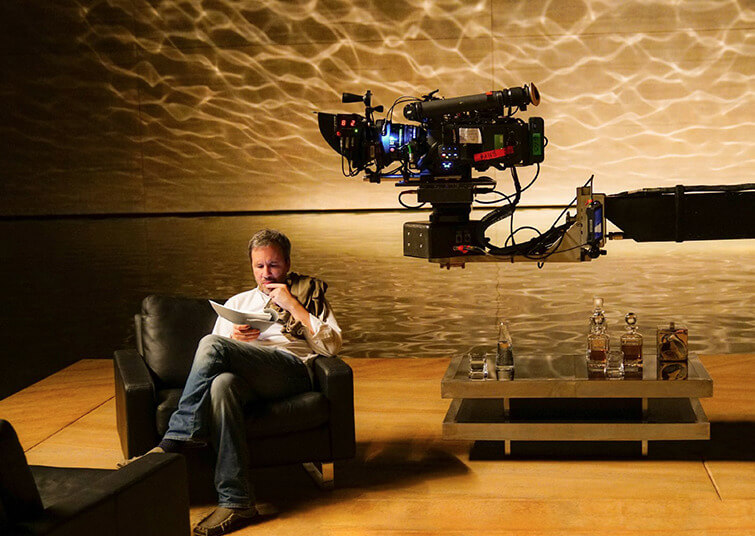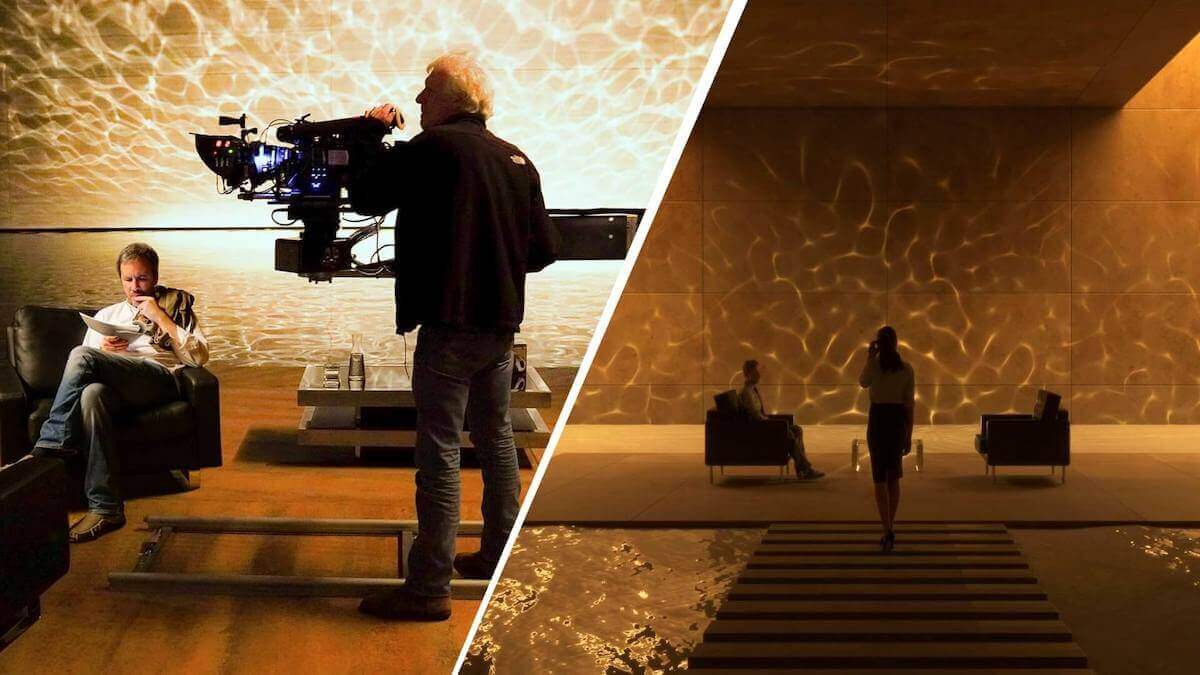In 2018, Roger Deakins finally won his first Oscar for Best Cinematography for Blade Runner 2049. And the world was not one bit shocked. As one of the most well respected cinematographers in the business, Deakins seems unable to make a less than beautiful film.
So we decided to take a look at the tricks and techniques Deakins uses to make average scenes visually stunning. One trick he uses is utilizing water reflections and patterns. In this article, we’ll take a look at how Deakins achieved this water light reflection effect in Blade Runner 2049. We’ll also break down how you can create a DIY water light reflection rig to achieve a similar effect on your own projects.
Water reflection light effect
Blade Runner 2049 water light reflection
Blade Runner 2049 is one of Roger Deakins most beautiful films. Let’s take a look at one specific scene in which water reflections are used. In this scene, Deckard finally meets Mr. Wallace. The set, inspired by architectural designs from research, was a large platform in the middle of a pond.

Villeneuve and the water light reflection effect
Light reflected off of the water onto large concrete walls behind the characters. According to Deakins, the idea of the water reflections “was to play with water with caustic patterns to evoke different emotions.” This idea was undoubtedly achieved and resulted in one of the more emotional and beautiful dialogue scenes of the film.
Blade Runner 2049 • Water light reflection effect
For the benefit of filmmakers, cinematographers, and film buffs, Deakins’ cinematography techniques are often discussed on Deakins’ forum. On a thread regarding Blade Runner 2049, Deakins explains the water light reflection rig.

“The water was lit with 10K Fresnel lamps. There were two per side making eight in all. It was a very tricky rig because it had to be quite high, so as to not be in shot, and the lamps had to have the right angle to reflect and spill across the wall as they do. I was originally expecting that I could do this effect without lighting the water so much. The bottom of the pool had been painted black so, in my naiveté, I thought it would stay quite dark. Consequently I asked my gaffer, Billy O'Leary, to construct long barn door extenders so that the pattern of light on the water would be a pleasing symmetrical shape and the light from the two lamps would merge together.”
— Roger Deakins
The result of the water reflection rig is as beautiful as it is effective. The caustic patterns contributed to the tone of the film and genre. Maybe you don’t have the resources that Roger Deakins has, but you would like to achieve a similar water reflection light effect. Let’s take a look at a DIY water reflections rig that you can use with minimal cost.
Related Posts
Light reflecting off water in video
DIY water reflection light rig
Light reflecting off water can create some stunning images, elicit emotion in your audience, and increase your project’s production value. So how do you achieve the water reflection light effect without breaking the bank?
A DIY water reflection light rig doesn’t require too many supplies, but it does require trial and error. The Youtube channel Chungdha has created a simple tutorial to create a DIY water reflection rig.
IMPORTANT NOTE: Water in the area of lights and electronics can be extremely dangerous. Safety when creating and using this rig is imperative. Ensure that there is one person on set, typically the key grip, who’s sole responsibility is to make sure the water and lights are handled safely.
DIY water reflection light by Chung Dha
Keep in mind that this rig is only a blueprint. Light reflecting in water can vary depending on the size of the mirrors, the depth of the water, and the angles of your light will create different effects. Trial and error is necessary in order to achieve the look you desire. Let’s recap the DIY water light reflection effect rig.
Supplies:
- Mirror or reflective foil
- Large water container
- Gaff tape
- Fan
- Spotlight
Step 1
Using tape, secure the mirror or reflective foil to the bottom of the container that you will fill with water. This can be a large plastic tub, kiddy pool, etc.
Step 2
Place the container as close to its final position as possible. This is necessary for safety to minimize moving the container when it's already filled with water. Fill the container with water.
Step 3
Place a fan close to the water to cause motion and ripples. This will help create moving patterns in your reflection.
Step 4
Point your spot light toward the water and mirror and adjust the intensity and angle until it creates the reflections you desire. Light reflecting in water will change depending on how you position these variables. Using a spotlight or some barndoors is important because you need a harsh source to get light reflecting off water in distinct patterns.
Oftentimes, we see a shot on screen and wonder “How did they do that?” like the light reflecting in water in Blade Runner 2049. If you take the time to reverse engineer the cinematography techniques that some of the best cinematographers use, you’ll be able to add a few tricks up your sleeve.
UP NEXT
Roger Deakins cinematography tips
The water light reflection effect from Blade Runner 2049 is only one of countless cinematography tricks you can learn from Roger Deakins. To learn about Deakins’ cinematography tips and fundamental techniques, check out our next article. We break down everything from the lenses Deakins uses to how he approaches lighting a scene.
Up Next: Deakins tips →
Showcase your vision with elegant shot lists and storyboards.
Create robust and customizable shot lists. Upload images to make storyboards and slideshows.
